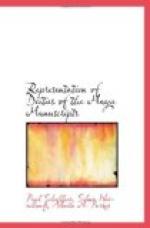Furthermore the following four well-known symbols of sacrificial gifts appear in connection with god B in the Dresden manuscript; a sprouting kernel of maize (or, according to Foerstemann, parts of a mammal, game), a fish, a lizard and a vulture’s head, as symbols of the four elements. They seem to occur, however, in relation also to other deities and evidently are general symbols of sacrificial gifts. Thus they occur on the two companion initial pages of the Codex Tro.-Cortesianus, on which the hieroglyphs of gods C and K are repeated in rows (Tro. 36-Cort. 22. Compare Foerstemann, Kommentar zur Madrider Handschrift, pp. 102, 103). God B is also connected with the four colors—yellow, red, white and black—which, according to the conception of the Mayas, correspond to the cardinal points (yellow, air; red, fire; white, water; black, earth) and the god himself is occasionally represented with a black body, for example on Dr. 29c, 31c and 69. This is expressed in the hieroglyphs by the sign, Fig. 9, which signifies black and is one of the four signs of the symbolic colors for the cardinal points.
God B is represented with all the four cardinal points, a characteristic, which he shares only with god C, god K, and, in one instance, with god F (see Tro. 29*c); he appears as ruler of all the points of the compass; north, south, east and west as well as air, fire, water and earth are subject to him.
Opinions concerning the significance of this deity are much divided. It is most probable that he is Kukulcan, a figure occurring repeatedly in the mythology of the Central American peoples and whose name, like that of the kindred deity Quetzalcoatl among the Aztecs and Gucumatz among the Quiches, means the “feathered serpent”, “the bird serpent”. Kukulcan and Gucumatz are those figures of Central American mythology, to which belong the legends of the creation of the world and of mankind. Furthermore Kukulcan is considered as the founder of civilization, as the builder of cities, as hero-god, and appears in another conception as the rain-deity, and—since the serpent has a mythologic relation to water—as serpent deity. J. Walter Fewkes, who has made this god-figure of the Maya manuscripts the subject of a monograph (A Study of Certain Figures in a Maya Codex, in American Anthropologist, Vol. VII, No. 3, Washington, 1894), also inclines to the belief that B is the god Kukulcan, whom he conceives of as a serpent-and rain-deity. This view has been accepted by Foerstemann (Die Tagegoetter der Mayas, Globus, Vol. 73, No. 10) and also by Cyrus Thomas (Aids to the Study of the Maya Codices, Washington, 1888). The same opinion is held also by E. P. Dieseldorff, who, a resident of Guatemala, the region of the ancient Maya civilization, has instituted excavations which have been successful in furnishing most satisfactory material for these researches (see Dieseldorff: Kukulcan, Zeitschrift fuer Ethnologie, 1895, p. 780).




